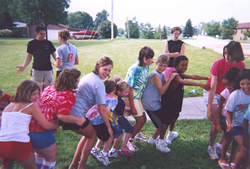 |
| It's all about team work! Youth participate in the TWP program participate in a team building activity. |
TWP worked with children between the ages of 5 and 15 who had disabilities such as cerebral palsy, autism, spina bifida, attention deficit hyperactive disorder (ADHD), learning disability (LD), behavior disorder (BD), intellectual disabilities, including Down Syndrome, seizure disorder, or bipolar disorder (Scholl, Dieser, et al., 2005). Each child was assessed by a CTRS to determine skill level to ensure that each child would be enrolled in the appropriate program.
Assessments involved three parts:
- the Annual Information Form (AIF) which requests information about the child's physical abilities, mobility, dietary restrictions, communication and personal care needs, behavior/personality and swimming abilities;
- a leisure interest survey; and
- an interview with the child, the child's teacher, and/or his or her social worker. The leisure interest survey focuses on identification of specific leisure activity interests, as well as preferred leisure style and barriers to community participation.
 |
| A leisure companion encourages a boy during an activity. |
After assessments have been completed, the CTRS, parent, and child work together to find the appropriate programs. In most instances, children participating in recreation activities were accompanied by a leisure companion to provide assistance. Leisure companions are college students majoring in therapeutic recreation or special education, hired and trained by the CTRS, who worked on a part-time basis. Prior to initial contact with the participant, the leisure companion received 1:1 training with the CTRS specifically related to the child's ability and support needs as stated on the child's AIF. The role of the leisure companion was not to facilitate the actual recreation activity, but to assist in the facilitation of the child's goals and assist with daily living tasks including toileting, dressing, etc. (Scholl, Dieser, et al., 2005). After each recreation or after-school session, the companion documented the participant's progress toward accomplishing the individual goals, significant incidents, and any other situations that the leisure companion observed.


